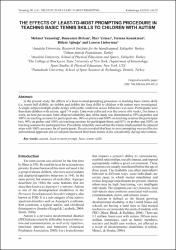The Effects of Least-To-Most Prompting Procedure in Teaching Basic Tennis Skills to Children With Autism

View/
Access
info:eu-repo/semantics/openAccessDate
2011Author
Yanardağ, MehmetBirkan, Bünyamin
Yılmaz, İlker
Konukman, Ferman
Agbuga, Bülent
Lieberman, Lauren
Metadata
Show full item recordAbstract
In the present study, the effects of a least-to-most prompting procedure in teaching basic tennis skills (i.e. tennis ball dribble, air dribble and dribble the lines drills) to children with autism were investigated. A single-subject multiple-probe design with probe conditions across behaviors was used. Participants were four male children with autism, aged 7-9 years. Data were collected over the course of 6 weeks, five times a week, an hour per session. Inter-observer reliability data of the study was determined as 93% on probes and 100% on teaching sessions for participant one, 96% on probes and 100% on teaching sessions for participant two, 90% on probes and 100% on teaching sessions for participant three, and 93% on probes and 100% on teaching sessions for participant four. Procedural reliability showed that the trainer implemented the planned steps with 100% accuracy for all participants. Results revealed that least to most prompting was an effective instructional approach and all subjects increased their basic tennis skills considerably during intervention.
Source
KinesiologyVolume
43Issue
1Collections
- Makale Koleksiyonu [134]
- WoS İndeksli Yayınlar Koleksiyonu [7605]

















